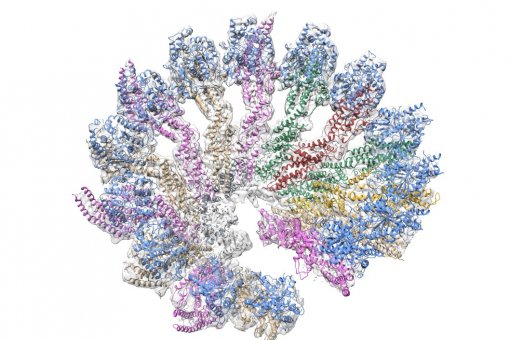Images
Contact

Researchers discover that the binding of three proteins is required to activate the programme of genes that are involved in the development of the nervous system of the fruit fly.
Cells have to activate or repress the genes packaged in their nucleus in order to perform the multiple biological functions required. To manipulate the genes, cells use diverse pieces of molecular machinery, which, when joined, act as switches. Researchers at the Institute for Research in Biomedicine (IRB Barcelona) have now discovered a new molecular machine and have partially described its function. This machinery involves three proteins, which, together, activate an extensive gene programme that triggers the development of the nervous system of Drosophila melanogaster, commonly known as the fruit fly. The study, performed by researcher Joan Font, a member of Ferran Azorín’s team, will be published this week in the scientific journal Genes and Development.
An unexpected component, HP1c, participates in the molecular machine discovered. This protein belongs to the HP1 family of proteins, whose main function in relation to genes has always been to repress them, to silence them. In other words, wherever HP1 is present, genes are "asleep". A distinct function for this protein has now been revealed. Azorín explains, "we have extended the array of functions exerted by HP1 as we have found HP1c acting in the control and execution of a programme of genes". Furthermore, the researchers consider that this new machinery is probably active in other gene programmes with distinct functions, not only in the programme that comprises the nervous system. "But to confirm that this is a generic regulatory machine of multiple genes and genetic programmes, we have to study its functions in distinct contexts and developmental stages in greater depth", explains Azorín.
Connection with health
The other two components in this molecular machinery are two transcription factors, called WOC and ROW, responsible for binding to the pertinent DNA sequence. Each of these three components is required for the complex to be functional. If one is missing, the gene programme is not activated and the fly’s brain does not develop.
Two of the three proteins of this genetic regulatory machinery have "sister proteins" identified in humans, which, when altered, lead to disease. For example, alterations of human HP1 are associated with the appearance of breast cancer and modifications in the protein homologue of WOC are associated with lymphomas (a kind of blood cancer) and metal retardation. To date, little is known about the ROW protein. "It is important that we concentrate on elucidating the function of the molecular complex because it may help us to clarify its role in human pathologies in which we know several components are altered", says Font.
The next step for Azorín’s team will be to study in greater depth the function of the machinery in the development of the central nervous system of the fly, to identify all the genes that it activates and to determine the functions of each one. In this next task, these researchers will be supported by the Gene Expression and Biostatistics Platforms at IRB Barcelona, managed by the scientists Herbert Auer and David Rossell respectively. Their contribution to the identification of the gene programme that is controlled by the genetic regulatory machinery described has been crucial in this first study.
Unexpected friends for HP1c proteins
Font’s work also makes a more theoretical contribution to epigenetic regulation and the coding, if present, underlying it. For approximately a decade, it has been known that the information held in genes goes further that the mere genetic sequence. That is to say, what determines whether some genes are expressed or repressed depends to a certain extent on the biochemical packaging that surrounds DNA. The packaging that DNA forms in the cell nucleus is chromatin (includes DNA and histone proteins) and the mechanisms and modifications that DNA and its packaging undergo would be epigenetic alterations. Finding the additional layer of information and therefore the epigenetic regulatory code currently represents one of the world’s greatest biomedical challenges.
Until now, the HP1 proteins had been found collaborating only with histones (chromatin proteins), and therefore, were considered epigenetic regulators of the genome that are normally involved, as explained previously, in gene silencing functions. However, this study demonstrates that they are also associated with transcription factors. Thus, the HP1c protein, although having histones in the same region and to which it normally binds, also associates with WOC and ROW. "It was accepted that HP1c localized in the region because of the presence of modified histones that recruited it, thereby suggesting that this family, the HP1 family, forms part of an epigenetic regulatory mechanism", explains Font. "We are not saying that a histone code does not exist, but this study shows that we still do not fully understand the contribution of HP1 proteins to histone recognition and to epigenetic regulations or whether the underlying mechanism is general or not, and consequently, whether it forms part of a code". This study opens up new possibilities.
Reference article:
Drosophila HP1c isoform interacts with the zinc-finger proteins WOC and Relative-of-WOC to regulate gene expression
Joan Font-Burgada, David Rossell, Herbert Auer and Fernando Azorín
Genes and Development, November 2008 (doi/10.1101/gad.481408)
About IRB Barcelona
The Institute for Research in Biomedicine (IRB Barcelona) pursues a society free of disease. To this end, it conducts multidisciplinary research of excellence to cure cancer and other diseases linked to ageing. It establishes technology transfer agreements with the pharmaceutical industry and major hospitals to bring research results closer to society, and organises a range of science outreach activities to engage the public in an open dialogue. IRB Barcelona is an international centre that hosts 400 researchers and more than 30 nationalities. Recognised as a Severo Ochoa Centre of Excellence since 2011, IRB Barcelona is a CERCA centre and member of the Barcelona Institute of Science and Technology (BIST).




